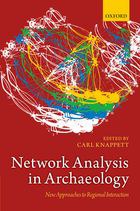Network Analysis in Archaeology
豆瓣
New Approaches to Regional Interaction
Knappett, Carl
简介
Networks are currently one of the most exciting areas of interdisciplinary research
Each chapter contains a unique case study, which have wide temporal range - from early prehistory to the present
Richly illustrated throughout with network diagrams
While the study of networks has grown exponentially in the past decade and is now having an impact on how archaeologists study ancient societies, its emergence in the field has been dislocated. This volume provides a coherent framework on network analysis in current archaeological practice by pulling together its main themes and approaches to show how it is changing the way archaeologists face the key questions of regional interaction.
Working with the term 'network' as a collection of nodes and links, as used in network science and social network analysis, it juxtaposes a range of case studies and investigates the positives and negatives of network analysis. With contributions by leading experts in the field, the volume covers a broad range: from Japan to America, from the Palaeolithic to the Precolumbian.
Readership: For students and scholars interested in archaeology, ancient history, sociology, economics, and classical studies.
contents
Acknowledgements
List of Figures
List of Contributors
Part I: Background
1: Introduction: why networks? Carl Knappett
2: John Edward Terrell: Social network analysis and the practice of history
3: Leif Isaksen: 'O what a tangled web we weave' - towards a practice that does not deceive
Part II: Sites and Settlements
4: Søren Sindbæk: Broken links and black boxes: material affiliations and contextual network synthesis in the Viking world
5: Jonathan B. Scholnick, Jessica L. Munson, and Martha J. Macri: Positioning power in a multi-relational framework: a social network analysis of Classic Maya political rhetoric
6: What makes a site important? Centrality, gateways and gravity
7: Koji Mizoguchi: Evolution of prestige good systems: an application of network analysis to the transformation of communication systems and their media
Part III: Material Culture
8: Barbara J. Mills, John M. Roberts, Jeffery J. Clark, William R. Haas Jr., Deborah Huntley, Matthew A. Peeples, Lewis Borck, Susan C. Ryan, Meaghan Trowbridge and Ronald L. Breiger: The dynamics of social networks in the Late Prehispanic U.S. Southwest
9: Emma Blake: Social networks, path dependence, and the rise of ethnic groups in pre-Roman Italy
10: Anna Collar: Re-thinking Jewish ethnicity through social network analysis
11: Fiona Coward: Grounding the net: social networks, material culture and geography in the Epipalaeolithic and early Neolithic of the Near East (~21-6,000 cal BCE)
12: S. Colby Phillips and Erik Gjesfjeld: Evaluating adaptive network strategies with geochemical sourcing data: a case study from the Kuril Islands
13: Angus Mol and Jimmy Mans: Old boy networks in the indigenous Caribbean
Part IV
14: Sander van der Leeuw: Archaeology, networks, information processing, and beyond